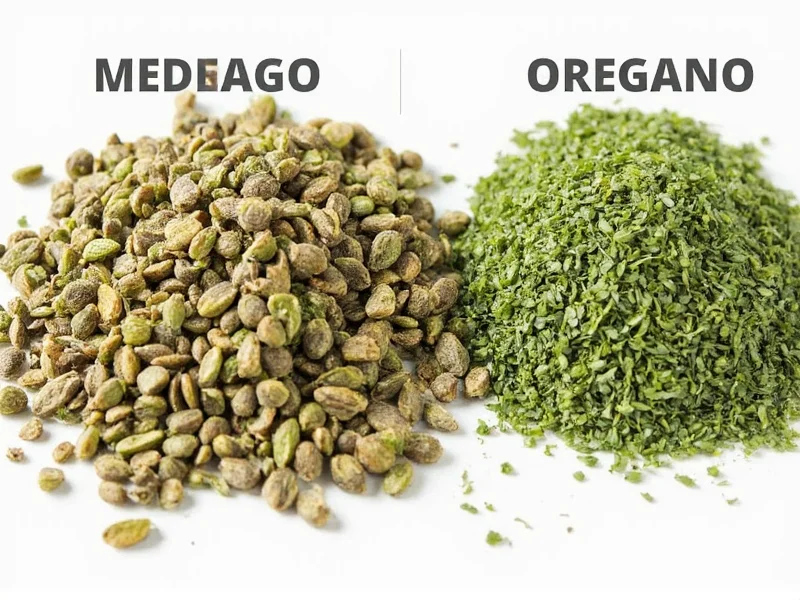Understanding the difference between Mexican oregano and oregano is essential for authentic cooking, especially when preparing Latin American or Mediterranean dishes. Though they share the same common name, these herbs come from completely different botanical families and offer unique flavor experiences that significantly impact your culinary results.
Botanical Classification: More Than Just a Name
Mexican oregano belongs to the Verbenaceae family and carries the scientific name Lippia graveolens. Despite its name, it's actually related to lemon verbena rather than true oregano. Mediterranean oregano, commonly referred to as Greek or European oregano, is Origanum vulgare from the Lamiaceae (mint) family. This fundamental botanical difference explains why their flavor compounds vary significantly.
Physical Characteristics Comparison
Mexican oregano features larger, rougher leaves with prominent veins and grows as a woody shrub in arid climates. The leaves tend to be more elongated and less rounded than its Mediterranean counterpart. Mediterranean oregano displays smaller, oval-shaped leaves with a soft, fuzzy texture and grows as a low-lying perennial herb.
| Characteristic | Mexican Oregano | Mediterranean Oregano |
|---|---|---|
| Botanical Name | Lippia graveolens | Origanum vulgare |
| Plant Family | Verbenaceae | Lamiaceae (mint) |
| Native Region | Mexico, Central America | Mediterranean region |
| Primary Flavor Notes | Citrus, licorice, earthy | Peppery, herbal, slightly bitter |
| Key Chemical Compounds | Thymol, carvacrol, eugenol | Carvacrol, thymol, gamma-terpinene |
Flavor Profile: Why Substitution Matters
The difference between Mexican oregano and oregano becomes most apparent when tasting them. Mexican oregano delivers a robust, slightly citrusy flavor with distinct notes of lemon and licorice, plus a warm earthiness. Mediterranean oregano offers a more complex profile with peppery, herbal notes and subtle bitterness. When comparing Mexican oregano vs Mediterranean oregano, the former contains higher concentrations of eugenol (also found in cloves), which creates its distinctive warm, spicy character.
Cooking with the wrong variety can dramatically alter your dish. Mexican oregano stands up well to long cooking times in soups, stews, and braises, while Mediterranean oregano works better when added toward the end of cooking or used fresh in salads and tomato-based dishes.
Culinary Applications Across Cuisines
Mexican oregano plays a vital role in authentic Latin American cooking, particularly in Mexican, Tex-Mex, and Central American cuisines. You'll find it essential in traditional dishes like mole, pozole, adobo sauces, and bean dishes where its citrus notes complement chilies and tomatoes. Chefs often wonder if they can substitute Mexican oregano for regular oregano in these recipes, but doing so creates noticeably different results.
Mediterranean oregano shines in Italian, Greek, and Middle Eastern cooking. It's the herb you want for pizza, pasta sauces, Greek salads, and grilled meats. When exploring the difference between Mexican oregano and oregano in cooking applications, remember that Mediterranean varieties pair beautifully with olive oil, garlic, and tomatoes.
Substitution Guidance for Home Cooks
While understanding what does Mexican oregano taste like compared to oregano helps prevent recipe failures, sometimes substitutions become necessary. If you lack Mexican oregano, combine regular oregano with a pinch of cumin and a few drops of lemon juice to approximate its flavor profile. For Mediterranean oregano substitution, use marjoram (its close relative) or a combination of thyme and basil.
When considering can I substitute Mexican oregano for regular oregano, remember that Mexican oregano's stronger flavor means you should use about half the amount called for in recipes specifying Mediterranean oregano. The reverse substitution requires increasing the amount slightly while adding complementary flavors.
Availability and Storage Tips
Finding authentic Mexican oregano can be challenging outside Latin American markets. Look for it in the international spice section or specialty herb stores. Mediterranean oregano appears more widely in standard grocery stores, often labeled simply as "oregano." When comparing Mexican oregano vs regular oregano on store shelves, check the botanical name on the label to ensure you're getting the correct variety.
Both varieties retain flavor best when stored in airtight containers away from light and heat. Mexican oregano maintains its potency longer than Mediterranean varieties due to its higher essential oil content. For optimal flavor, replace dried oregano every 6-12 months.
Common Misconceptions Clarified
Many cooks mistakenly believe Mexican oregano is simply a stronger version of regular oregano. In reality, they're botanically unrelated plants with different chemical compositions. Another misconception is that Cuban oregano (Plectranthus amboinicus) relates to either variety—it's actually a succulent in the mint family with a completely different flavor profile.
When examining the difference between Mexican oregano and oregano, remember that regional variations exist within Mediterranean oregano types. Greek oregano tends to be more pungent than Italian varieties, but all remain distinctly different from Mexican oregano.
Practical Cooking Recommendations
For authentic Mexican dishes like enchilada sauce or carne asada marinade, Mexican oregano delivers the traditional flavor profile that Mediterranean varieties cannot replicate. Its citrus notes cut through rich meats and complement chilies beautifully. When making Italian tomato sauces or Greek dressings, Mediterranean oregano provides the characteristic herbal notes that define these cuisines.
Understanding the difference between Mexican oregano and regular oregano helps you make informed choices when following recipes from different culinary traditions. Keep both varieties in your spice collection if you cook across multiple cuisines, clearly labeling them to avoid confusion.











 浙公网安备
33010002000092号
浙公网安备
33010002000092号 浙B2-20120091-4
浙B2-20120091-4